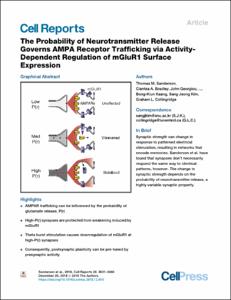The Probability of Neurotransmitter Release Governs AMPA Receptor Trafficking via Activity-Dependent Regulation of mGluR1 Surface Expression
- Title
- The Probability of Neurotransmitter Release Governs AMPA Receptor Trafficking via Activity-Dependent Regulation of mGluR1 Surface Expression
- Author(s)
- Sanderson, Thomas M. ; Bradley, Clarrisa A. ; Georgiou, John ; Hong, Yun Hwa ; Ng, Ai Na ; Lee, Yeseul ; Kim, Hee-Dae ; Kim, Doyeon ; Amici, Mascia ; Son, Gi Hoon ; Zhuo, Min ; Kim, Kyungjin ; Kaang, Bong-Kiun ; Kim, Sang Jeong ; Collingridge, Graham L.
- Issued Date
- 2018-12
- Citation
- Cell Reports, v.25, no.13, pp.3631 - 3646.e3
- Type
- Article
- Author Keywords
- AMPA ; DHPG ; FM dye ; Long-term depression ; LTD ; metabotropic ; mGluR ; P(r) ; probability of release ; theta burst
- Keywords
- LONG-TERM DEPRESSION ; METABOTROPIC GLUTAMATE-RECEPTOR ; PRESYNAPTIC FUNCTION DRIVEN ; DHPG-INDUCED LTD ; SYNAPTIC-TRANSMISSION ; RAT HIPPOCAMPUS ; CA1 REGION ; AREA CA1 ; ACTIVATION ; INTERNALIZATION
- ISSN
- 2211-1247
- Abstract
- A major mechanism contributing to synaptic plasticity involves alterations in the number of AMPA receptors (AMPARs) expressed at synapses. Hippocampal CA1 synapses, where this process has been most extensively studied, are highly heterogeneous with respect to their probability of neurotransmitter release, P(r). It is unknown whether there is any relationship between the extent of plasticity-related AMPAR trafficking and the initial P(r) of a synapse. To address this question, we induced metabotropic glutamate receptor (mGluR) dependent long-term depression (mGluR-LTD) and assessed AMPAR trafficking and P(r) at individual synapses, using SEP-GluA2 and FM4-64, respectively. We found that either pharmacological or synaptic activation of mGluR1 reduced synaptic SEP-GluA2 in a manner that depends upon P(r); this process involved an activity-dependent reduction in surface mGluR1 that selectively protects high-P(r) synapses from synaptic weakening. Consequently, the extent of postsynaptic plasticity can be pre-tuned by presynaptic activity. © 2018 The AuthorsSynaptic strength can change in response to patterned electrical stimulation, resulting in networks that encode memories. Sanderson et al. have found that synapses don't necessarily respond the same way to identical patterns, however. The change in synaptic strength depends on the probability of neurotransmitter release, a highly variable synaptic property. © 2018 The Authors
- Publisher
- Cell Press
- Files in This Item:
-
 기타 데이터 / 4.62 MB / Adobe PDF
download
기타 데이터 / 4.62 MB / Adobe PDF
download
- Appears in Collections:
- ETC 1. Journal Articles



